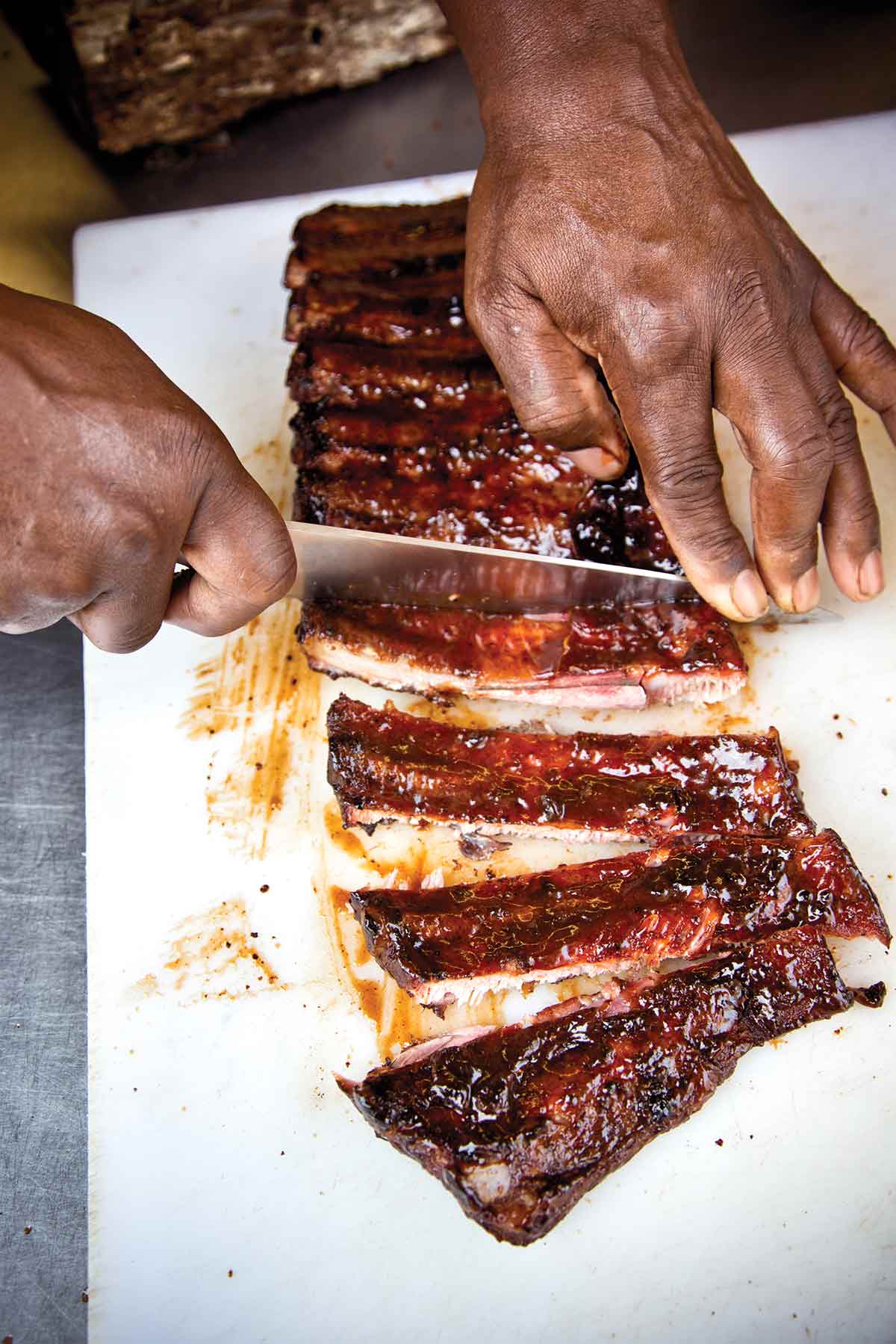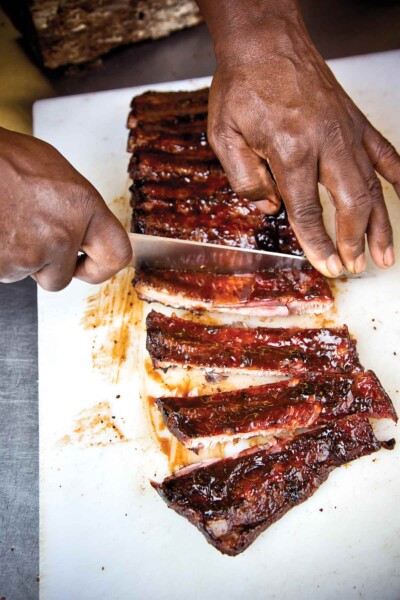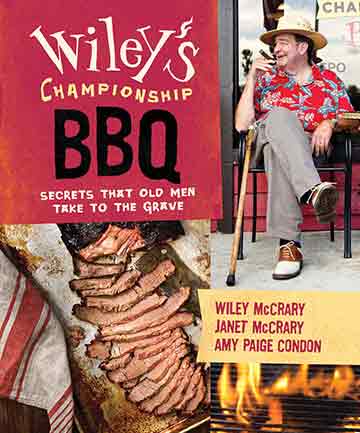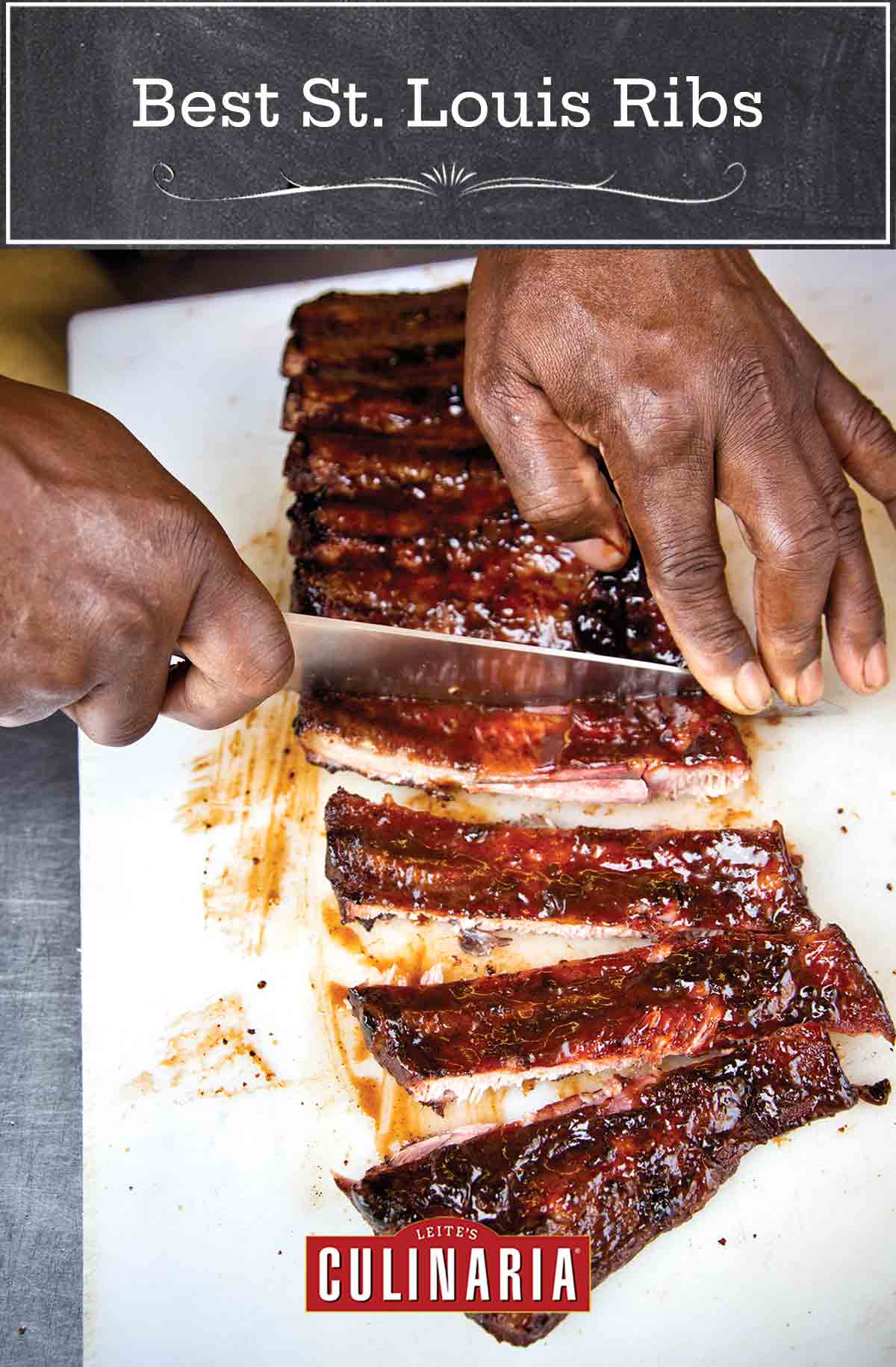
If I can teach one thing to my students – aside from internal temperature always prevails over time – it’s to disabuse them of this notion that rib meat should be so tender it “falls off the bone.” You’d be laughed off the competition circuit if you turned in a rib without meat on it. However, a rib should pull away cleanly from the bone as you eat it-holding it with your fingers, not cutting it away with a knife and fork.—Wiley McCrary
What is the Purpose of a Barbecue Rub?
Mostly, it’s the secret to a good bark—that crisp crust atop a brisket, butt, or ribs. Bark starts with a generous massage of a pungent, smoky rub that caramelizes and deepens during the low-and-slow smoking process. Adapt the basic rub to suit your tastes. For a more intense caramel flavor, substitute turbinado or brown sugar, one to one, for the granulated sugar in the recipe. Experiment by adding different brands of dry mustards. Vary the types of chili powders, using a smoky ancho, for example. Throw in some oregano or thyme. Don’t skip the rub, it’s what gives your meat that perfect barbecue finish. But remember, the rub is never the predominant flavor—that’s what the sauce is for.

Amazing St. Louis Ribs
Equipment
- Smoker
Ingredients
For the Q Company’s Basic Rub
- 1 cup granulated sugar
- 1/2 cup Hungarian paprika
- 1/4 cup seasoning salt
- 1/4 cup granulated garlic
- 1/4 cup onion salt
- 1/4 cup celery salt
- 1/4 cup chili powder
- 1/4 cup black pepper
- 1 teaspoon ground dry mustard
- 1/2 teaspoon cayenne pepper
For the Q Company’s Basic BBQ Sauce
- 5 cups ketchup
- 1/2 teaspoon celery salt
- 2/3 cup dark amber maple syrup
- 1 tablespoon apple cider vinegar
- 1 tablespoon molasses
- 1 tablespoon granulated garlic
- 1 tablespoon chili powder
- 1 tablespoon dry mustard
- 1 tablespoon hot sauce
- 1 scant teaspoon Worcestershire sauce
- 1/2 teaspoon ground cumin
For the ribs
- 2 to 3 racks St. Louis-style pork ribs
- Olive oil
Instructions
Make the Q Company’s Basic Rub
- Combine all the ingredients in an airtight container and shake vigorously until thoroughly mixed. You should have about 3 cups. (You can store the leftover rub in a dry, cool place for up to 6 months.)
Make the Q Company’s Basic BBQ Sauce
- Combine all the ingredients in a medium nonreactive saucepan over low heat. Gently simmer, stirring occasionally, for at least 20 minutes. Set aside to cool to room temperature. You should have about 6 1/2 cups. (You may use the sauce immediately or store it in an airtight container in the refrigerator for up to 3 months.)
Make the St. Louis ribs
- Pat the ribs completely dry. Place the ribs, meaty side down, on your work surface. Use a butter knife or skewer to remove the silver skin on the underside of each rack of ribs. (The silver skin is the thick, shiny, opaque membrane that runs the length of the rack. To remove it, starting with the second bone, insert the knife or skewer between the membrane and the bone and rip or pull off the entire length of the silver skin, holding onto it with a paper towel because it gets slippery. Make sure the entire silver skin is removed, because it will keep the rub from flavoring the meat and it's tough to chew.) Repeat this procedure for each rack of ribs.
- Coat the racks with 1 cup rub and massage the spices into the meat. You want to coat the ribs evenly. Add a generous drizzle olive oil to each rack and smear it over the ribs to sorta turn the rub into a paste. Store the ribs in a super large resealable plastic bag in the refrigerator for at least 6 hours and preferably overnight.
- To cook the ribs in the smoker: Heat the smoker to between 225° and 240°F (107° and 115°C). Place the ribs, meaty side down, on the grill grate. Leave the ribs in this position for 1 hour. Then flip the ribs and cook for 1 hour more. Mop the top of the ribs with some of the barbecue sauce then flip the ribs meaty side up. Mop the meaty side of the ribs and cook for another 30 minutes or until each rack of ribs bends in the middle when it's picked up with tongs. To cook the ribs on a gas grill: Put your soaked wood chips in an aluminum pie plate and cover the top tightly with aluminum foil. With a butter knife, poke about 10 holes in the foil. Remove the grates from one side of your grill and place the pie plate directly on those burners. Light your grill and set only the burners underneath the wood chips on their lowest setting. If there is a large vent on the side of the grill with the wood chips, plug it with an old rag to prevent the smoke from escaping. Keep your meat on the opposite side of the grill, where the grates are still in place. Wait for the wood to start smoking—at least 15 minutes—before you place your meat on the grill. Heat the grill to between 225° and 240°F (107° and 115°C). Place the ribs, meaty side down, on the grill grate. Leave the ribs in this position for 1 hour. Then flip the ribs and cook for 1 hour more. Mop the top of the ribs with some of the barbecue sauce then flip the ribs meaty side up. Mop the meaty side of the ribs and cook for another 30 minutes or until each rack of ribs bends in the middle when it's picked up with tongs.
- Remove the ribs from the grill grate, brush them with more sauce, then cover with foil and let them rest for 20 to 30 minutes before serving.
Notes
Variations on the barbecue sauce
Over the years, we’ve experimented with any number of barbecue sauces—some with jaw-clenching tartness, others with honeyed sweetness. We encourage you to play with this sauce’s notes. For a sweeter sauce, substitute honey for molasses in the recipe. For a sauce that packs more tingle, throw in some crushed red pepper flakes. For a smokier sauce, add ground ancho chile powder. The point, dear readers, is to make it suit your own taste.
Explore More with AI
Nutrition
Nutrition information is automatically calculated, so should only be used as an approximation.
Want to Save This?
Recipe Testers’ Reviews
These amazing St. Louis ribs are among the best I’ve had. They’re meaty and tender with great flavor. The spice rub and barbecue sauce give the meat both sweetness and piquancy. The recipe works exactly as written.
The only differences were that we cooked the ribs on indirect heat on our gas grill rather than using a smoker and decided to leave the ribs on for 15 more minutes in the end to get a bit more caramelization. St. Louis-style ribs are perfect for this recipe. Baby backs might work, but won’t be as meaty, and the cooking time would have to be adjusted. In either event, don’t skip the step to remove the silver skin membrane, which allows the flavors from the spice rub to really permeate the meat.
You do need to plan ahead for this recipe because it will take you at least 10 hours from start to finish. I made half of the basic rub recipe, which was enough to coat 2 racks and still have about 3/4 cup leftover for the next time. I made only a quarter of the sauce recipe, and the yield was perfect for the 2 racks with a bit left over to use as a dip for French fries (since I ran out of ketchup). I strongly suggest that you use brown sugar in the rub recipe for a richer caramel flavor.
What great-tasting St. Louis ribs! Not quite fall-off-the-bone tender, but extremely juicy, tender, a tad spicy, and with the perfect amount of sweetness. Both my husband and I ate them without any extra barbecue sauce, but my daughters did give a little extra sweetness to them.
The rub was extremely easy to make, straightforward, and called for spices that are easy to find. As Portuguese paprika is pretty similar to Hungarian paprika, and I have quite a lot of the former at home, I decided to use that one. I used smoked ancho for my chili powder. I’ll be also trying the rest of the rub on grilled jumbo shrimp, as I think that will work well.
The barbecue sauce was also pretty self-explanatory and straightforward. I ended up getting a little closer to 7 cups of sauce and looking forward to using it for other purposes, as I ended up only using about 2 cups for this recipe. The timing was perfect. These amazing St. Louis ribs were gorgeous in color and smell, and the taste will not disappoint anyone.













Since I have never smoked any meat at all, are there any special instructions for smoking meat on a Weber charcoal grill?
Sandra, take a look at the instructions in step 3 of the recipe at the following link for smoking on a grill. The instructions explain the basic setup. You want to be sure to maintain as consistent a temperature as possible on your grill-turned-into-makeshift-smoker so you’ll want to frequently check on it. If you have any more questions, I suggest you cruise through the following site, which has all manner of terrific techniques pertaining to grilling and smoking.
I only have a gas grill and would like to try this recipe. How do I go about smoking these ribs in my gas grill?
Pamela, these are the instructions we include from a different recipe on the site. Happy smoking!
“If using a gas grill: Can you smoke meat with a regular gas grill? We’ve done it, and it’s effective if not perfect. This is an unsophisticated version of smoking, and real pit masters frown on it, but we’ve done it many times. The taste is not as intense, but the meat is still tender and delicious. If you want to try it, here’s how: Put your soaked wood chips in an aluminum pie plate and cover the top tightly with aluminum foil. With a butter knife, poke about 10 holes in the foil. Remove the grates from one side of your grill and place the pie plate directly on those burners. Light your grill and set only the burners underneath the wood chips on their lowest setting. If there is a large vent on the side of the grill with the wood chips, plug it with an old rag to prevent the smoke from escaping. Keep your meat on the opposite side of the grill, where the grates are still in place. Wait for the wood to start smoking—at least 15 minutes—before you place your meat on the grill.”
I’m from St. Louis and these ribs sound amazing. I will definitely give them a try. I’m sure my crew will give them the thumbs up.
Terrific, Vicki! Love to hear what they think…!